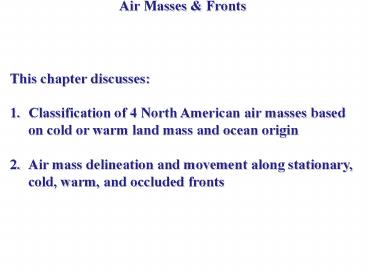Air Masses PowerPoint PPT Presentation
1 / 27
Title: Air Masses
1
Air Masses Fronts
- This chapter discusses
- Classification of 4 North American air masses
based on cold or warm land mass and ocean origin - Air mass delineation and movement along
stationary, cold, warm, and occluded fronts
2
Regional Weather Patterns
Surface maps of US temperature, dew point, and
pressure reflect synoptic trends. In this
image, nearly every station around the high
pressure anticlone reports cold, dry air,
suggesting the air mass formed in a common region.
Figure 12.1
3
Source Regions Classification
- Air masses of similar temperature and humidity
form above flat, uniform regions with light
surface winds. - US air masses originate from
- maritime Polar
- continental Polar
- maritime Tropical
- continental Tropical
- Letter 'k' is added to indicate the air mass is
colder than the land below, which warms the lower
air and causes instability.
Figure 12.2
4
Source Regions Classification
5
cP Wind Flow
Western mountains, such as the Rocky and Sierra
Nevada ranges, normally protect the Pacific
Northwest from cP air. Strong anticyclone
highs, however, can create northeast winds that
cause cold outbreaks along the western coast.
Figure 12.3
6
Summer Winter cP Air
Summer cP air over the US brings welcome relief
from heat, but also triggers steeper
environmental lapse rates and cumulus cloud
development. Cold surfaces during the winter
create temperature inversions.
Figure 12.4
7
Modification of cP Air
Figure 12.5
As the cP air mass moves over the warmer Gulf of
Mexico and Gulf Stream waters, surface warmed air
becomes unstable, rises, and forms extensive rows
of cumulus cloud streets.
8
Origin of mP Air
Cold Asian polar air passing over the ocean
south of the Aleutian low will pick up warmth and
moisture, and reaches the Pacific Coast as cool,
moist, and unstable, bringing rain and snow.
Figure 12.6
9
Modification of mP Air
Figure 12.7
Orographic precipitation lowers the moisture
content of mP air, called Pacific air east of the
Rockies, during its westward flow. Leeward of
the Rockies, the air is dry and may develop
chinook winds.
10
East Coast mP Air
A strong anticyclone in eastern Canada creates
northeasterly winds that may bring cold, unstable
Atlantic mP air and storms into New England and
the middle Atlantic States. These storms are
known as northeasters.
Figure 12.8
11
Tropical Pacific mT Air
Figure 12.9
Warm and moist maritime air from the tropical
Pacific may reach the West Coast as a series of
unstable and powerful thunderstorms.
12
Gulf Caribbean mT Air
Figure 12.10
Gulf of Mexico and Caribbean Sea warmth and
moisture flows into the East Coast by a strong
anticyclone. When it rises above dense cP air,
heavy and widespread precipitation can result.
13
Mexican Origion of cT Air
Dry, hot air from the Mexican desert can cause
low level instability in the US interior during
summer, and may trigger dust devils. An upper
level ridge of high pressure may add
compressionally heated air to the region,
enhancing the dry, hot conditions.
Figure 12.11
14
Air Mass Fronts
Figure 12.12
Two air masses entering a region, such as the US
middle latitudes, have a front, or transition
zone, between the strong temperature and humidity
differences. Four different fronts are used on
weather maps.
15
Front Identification
Locating a front on a weather map involves
finding sharp changes in a) temperature, b) dew
point, c) wind direction, d) pressure, and
cloud/precipitation patterns. In this figure,
pressure tendency is shown as the line to the
right of the station, where / is rising pressure.
Figure 12.13
16
Cold Front Transition
Figure 12.14
Important cloud, wind, and temperature changes
are revealed in this cross-section view of a
typical cold front. The front rises steeply (1km
in 50km), and cirriform clouds protrude ahead.
Frontogenesis describes a strengthening system,
which may send a fast moving squall line of
showers ahead of the front.
17
Strengthening Front
Figure 12.15A
Figure 12.15B
Satellite imagery shows the temporal transition
between a weak front and its frontogenesis, or
strengthening, as moves offshore over warmer
water.
18
Back Door Cold Front
Eastern Canadian high pressure can generate cold
fronts from the northeast, which mix with the
warm, moist Gulf air. Cold air damming
describes how the Appalachian Mountains confine
the front's westward movement.
Figure 12.17
19
Cold Front Forecasting
20
Warm Frontal Weather Trends
Observed wind, temperature, pressure, humidity,
clouds, and rain weather experiences typical
patterns before, during, and after a front.
Note the rotation of winds and change in
temperature along this warm front.
Figure 12.17
21
Warm Front Transition
Figure 12.18AB
Unique clouds and precipitation patterns are
associated with warm fronts, with a broader range
of showers than in a cold front. The
cross-sectional view shows the gentle slope of
overrunning warm air, a typical temperature
inversion, and the shifting winds.
22
Warm Front Forecasting
23
Cold-Type Occluded Fronts
Figure 12.19A
Fast moving cold fronts may overtake the slower
moving warm front, particularly when they are
influenced by cyclonic winds. Cold occlusion is
shown.
24
Warm-Type Occluded Fronts
Figure 12.20A
Warm occlusion is shown above.
25
Occluded Front Forecasting
26
Mid-Latitude Cyclone
Occluded fronts are common along mid-latitude
cyclones, or deep low pressures centers about
which the cold and warm fronts pivot. These
storms appear frequently in the mid-latitudes.
Figure 12.21
27
Upper Air Front
A division between cold and warm air masses in
the tropopause is described as an upper-air
front, which forms when polar jet rides above the
tropopause through tightly packed isotherms.
Figure 12.22

